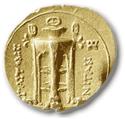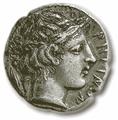Representation of Phoebus on coins
In the history of numismatics, the choice of iconographic types is of utmost importance. For the
engravers, the primary source of inspiration was the religious as well as mythological tradition of the issuing
authority. Indisputably, the ancient Greeks, being deeply dedicated to their faith in their Olympian gods, had
every reason to represent the patron god of their city on their coins. The worship of a deity in the city or the
wider region justifies the representation of this god on coins. However, in many cases the representation of a god
on coins happens to be the main evidence of the worship of this particular god in the area. Therefore, the coin -
a small, disc shaped metallic object, which has been weighed, sealed and put into circulation according to the law
of the issuing authority that guarantees its value - besides being a means of transaction, is also the conveyor
of a multitude of cultural and historical messages.
Athena and Phoebus - an alternative name for Apollo - were two of the most important gods of the
Greek Dodecatheonthe were chosen as the two official mascots of the Olympic Games ATHENS 2004. They held
a prominent place in the religious consciousness of the ancient Greeks and their qualities embodied all the
spiritual and moral assets of the Greek civilization. The two gods are the inventors and protectors of all
spiritual creation. Their lives and their myths inspired artists throughout ancient times and their numerous
representations in statues, pots and various works in relief are regarded today as excellent artifacts of highly
conceived art which belong to our universal cultural heritage.
God Phoebus
Apollo, god of the sun and music, was also named Phoebus (the bright, the shining). Invariably,
he is represented young, naked or in a foot-long tunic, wearing a laurel wreath on his head. The laurel became the
sacred plant of the god, supposedly after the metamorphosis of his beloved Nymph, Daphne (laurel). He was the deity
of all good and noble, the guide of the Muses (Musegetes) as well as the god of prophecy and divination. His
symbols were the lyre and the tripod.


According to myth, Apollo was the son of Zeus and Leto. Persecuted by Hera's jealousy, Leto
wandered from place to place, from Crete to Thrace and Asia Minor, searching for a place to give birth to her son.
Eventually, she sought refuge in the island of Delos, and under Mount Cynthos, Apollo was born. Naturally, Delos
became the sacred island of the god, and the magnificent temple established in the port hosted great festivals,
organized every five years and attended by theoroi from all over Greece. The iconographic type of the ancient coins
of Delos is the lyre, the god's symbol.
Phoebus on coins
In Macedonia, the worship of Apollo was widespread. The Chalkidian League, in the peninsula of
Chalkidike, managed to unite the Greek cities of the area in a powerful confederation, under the leadership of the
capital Olynthos. However, this state was not long-lived. In 348 B.C., Philip II invaded Chalkidike, dismantled the
Chalkidian League and literally devastated the capital. Although short-lived, this important confederacy of
northern Greece managed to issue a wide range of coins. The head adorning the obverse of the Chalkidian Confederacy
tetradrachms is among the most beautiful representations of Apollo in the art of numismatics. The reverse features
the lyre along with an inscription.
The grand temple of Apollo Aktios established in the city of Aktion, was the religious centre of
the Acarnanian Confederacy, where great festivals and games were organised in honour of the god. On the reverse of
certain Acarnanian drachms, Apollo Aktios is depicted seated, carrying a bow.
Apollo also appears on a coin of Eleutherna of Crete, holding bow and sphere. In this region, he
was worshipped as Apollo Styrakites and there was a temple dedicated to him.
In the west, the small gold editions of Tauromenion in Sicily, the tetradracms of Rhegion, of the
Leontinoi and the staters of Kaulonia in southern Italy confirm the worship of the god in Great Greece. Considering
the fact that Apollo is the god of colonists, it is only natural that he was worshipped in this region where the
great colonization by the Greeks took place.
As aforementioned, Phoebus was also the god of divination. Besides the great oracle in Delphi,
which evolved into the religious and political centre of Greece, other oracles were established throughout the
ancient world. Among them was the oracle of Kalchedon in Bithynia. The existence of this oracle provides
explanation for the iconographic type of Apollo upon omphalos on the tetradrachms of the city. There was also a
great temple and oracle in Klaros of Ionia, in the area of Kolophon, where the god was worshipped as the Klarian
Apollo. On the coins of the city, the head of the god is represented on the obverse while the reverse depicts his
symbol, the lyre. Another renowned temple and oracle was established further towards the south in Miletos - that
of Apollo Didymaios. Therefore, the Milesian coins too feature the head of the god.
Apollo, like Athena, is frequently referred to as the protector of royal families. The head of
Apollo is depicted on royal Macedonian coins, such as the gold staters of Philip II, the first Macedionian king to
become Olympic champion. Another excellent representation of the god is found on the reverse of the tetradrachms
issued under the authority of another Macedonian king, Antigonos Doson, where the god is depicted seated at a
ship's prow.
Worship of the god also existed in Paionia, in the area stretching from Illyria to the river
Strymon. Here, the god's head is engraved on the obverse of the tetradrachms issued by king Patraos.
Apollo sitting upon omphalos is featured on the reverse of the tetradrachms of the Seleucid
kings, such as the ones issued by Antiochos I, and also on the only tetradrachm known today of king Tigraios from
Elymais, a country south of Babylon.
It is here in the east that our journey comes to a conclusion. Athena and Phoebus, a reference
to the 2004 Olympics in Athens, become through these coins our guides to a wonderful journey through times and
places. The two gods take us back deep into the past and introduce us to cities and kings, even in remote and
distant regions, proving for once more the vast influence of Greek civilization and the magnificence of ancient
Greek art.